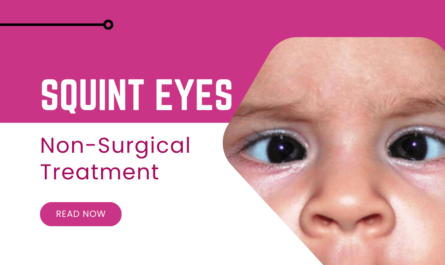Introduction
Eye health is a critical aspect of overall well-being, yet many people struggle to understand common conditions that affect vision. Strabismus and squint are two terms that are often used interchangeably, leading to confusion. However, while they are closely related, they are not exactly the same.
Understanding the differences between strabismus and squint is essential for accurate diagnosis and effective treatment. In this blog, we will explore their definitions, causes, symptoms, treatment options, and expert recommendations.
Understanding Strabismus Vs. Squint
What is Strabismus?
Strabismus is a medical condition in which the eyes do not align properly. One eye may look straight ahead while the other turns inward, outward, upward, or downward. This misalignment occurs because the eye muscles fail to work together in harmony. Strabismus can be present from birth or develop later in life due to various reasons, such as nerve damage or trauma.
What is Squint?

Squint is a general term that refers to the misalignment of the eyes. In many cases, people use the term “squint” synonymously with strabismus, especially in non-medical discussions. However, ophthalmologists sometimes use “squint” to describe a temporary or minor misalignment that might not necessarily classify as strabismus.
Causes, Symptoms, and Risk Factors
Causes of Strabismus and Squint
- Genetics: A family history of eye misalignment increases the risk of developing strabismus.
- Muscle Imbalance: Weak or improperly functioning eye muscles can cause misalignment.
- Nerve Issues: Damage to the nerves that control eye movement can result in strabismus.
- Refractive Errors: Uncorrected vision problems, such as farsightedness, may contribute to the development of squint.
- Medical Conditions: Neurological disorders, stroke, or head injuries can lead to strabismus.
Symptoms to Watch Out For
- Misaligned eyes (one eye pointing in a different direction)
- Double vision or blurry vision
- Frequent squinting or closing one eye
- Head tilting to compensate for misalignment
- Difficulty in depth perception and coordination
Who is at Risk?
- Infants and young children (congenital cases)
- Adults with underlying neurological or muscular conditions
- People with untreated vision problems
- Those with a family history of strabismus
Treatment Options for Strabismus and Squint
1. Glasses and Contact Lenses
In cases where refractive errors contribute to misalignment, corrective glasses or contact lenses can help improve vision and alignment.
2. Vision Therapy
Eye exercises and structured vision therapy sessions can help strengthen eye muscles and improve coordination.
3. Eye Patching
For children with amblyopia (lazy eye) along with strabismus, an eye patch may be recommended to strengthen the weaker eye.
4. Botox Injections
Botulinum toxin (Botox) injections can be used to temporarily weaken an overactive eye muscle, helping to improve alignment.
5. Surgery
In severe cases, eye muscle surgery may be required to realign the eyes and improve coordination. This is often recommended when other treatments are ineffective.
6. Lifestyle and Home Remedies
Maintaining a healthy diet, protecting the eyes from injury, and ensuring regular eye check-ups can contribute to overall eye health.
Expert Opinion: Dr. Smita Mukherjee
Dr. Smita Mukherjee is a senior ophthalmologist with over 30 years of experience. After completing her post-graduation from Seth G.S. Medical College with academic honors, she joined the faculty at the same college. Over the years, she has gained extensive experience in all branches of ophthalmology, training numerous post-graduate students.
Currently, she practices at Eye Solutions Clinic, Chembur, where she specializes in Cataract, Phacoemulsification, Refractive Errors, Diabetic Retinopathy, and Age-Related Macular Degeneration.
Clinic Information & Appointment Booking:
Eye Solutions Clinic
401, Pearl Belleza, D. K. Sandu Marg, 19th Road Corner, Chembur, Mumbai 400071
For appointments, visit the clinic or call ahead.
Frequently Asked Questions (FAQs)
1. Is strabismus the same as a lazy eye?
No. Strabismus refers to misaligned eyes, while lazy eye (amblyopia) is when one eye has reduced vision due to lack of use.
2. Can adults develop strabismus?
Yes. While common in children, strabismus can also develop in adults due to medical conditions, trauma, or nerve damage.
3. Is squinting a sign of eye problems?
Frequent squinting may indicate a refractive error or an attempt to compensate for misalignment. A professional eye exam is recommended.
4. Can strabismus be treated without surgery?
Yes. Glasses, vision therapy, Botox, and other non-surgical methods can help in some cases, but surgery may be needed for severe misalignment.
5. At what age should strabismus be treated?
Early diagnosis and treatment (before age 6) yield the best results, but treatment is effective at any age.
6. Can strabismus come back after treatment?
While some cases may require ongoing management, proper treatment can provide long-term correction.
7. How do I know if my child has strabismus?
Look for signs like misaligned eyes, head tilting, or difficulty focusing. An eye specialist can provide a definite diagnosis.
8. Does prolonged screen time cause squint or strabismus?
Excessive screen use can strain the eyes but does not directly cause strabismus. However, it may worsen underlying vision issues.
Conclusion
Strabismus and squint are closely related conditions that affect eye alignment and vision. Understanding their causes, symptoms, and treatment options is crucial for early intervention and effective management. If you or a loved one experiences eye misalignment, seeking professional consultation from an experienced ophthalmologist like Dr. Smita Mukherjee can ensure the best possible outcome.
Regular eye check-ups, a healthy lifestyle, and timely treatment can help maintain optimal eye health. Don’t ignore vision problems—get expert advice and take the right steps towards clear, healthy vision!

